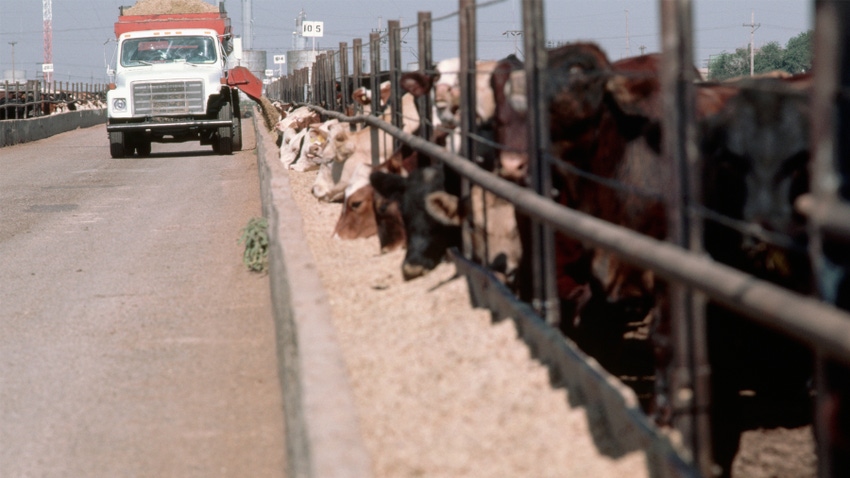
Cows eat grass. They digest that grass through fermentation in their ruminant stomach. And then they produce methane, a byproduct of that feed digestion.
And while some may find “cow burps” to be humorous, the cattle producer knows that they’re really a loss of feed energy and costly to their bottom line when it comes to their cow’s efficiency.
Improving feed efficiency in the cow is not only good for the cattle producer, but it’s also good for the environment, too. According to Kansas State University’s Beef Cattle Institute, feed additives could be effective in reducing enteric methane emissions from cattle. The most effective include methane inhibitors, electron acceptors, hydrogen sinks and plant extracts.
“These feed additives can reduce enteric methane emissions from 10% to 50%, depending on domestic ruminant species and diet,” according to BCI’s research.
One additive that shows promise, according to BCI, is 3-nitrooxypropanol (3-NOP). It’s been shown to reduce enteric methane formation in dairy cows by inhibiting the enzymes responsible for methane formation The additive 3-NOP reduces Methanobrevibacter enzymes, Methanobrevibacter which make methane from carbon dioxide; and Methanosphaera enzymes, which make methane from methanol. Research shows that when methane production is blocked by 3-NOP, hydrogen gas also accumulates less than expected in the rumen.
According to BCI, 3-NOP shifts the rumen profile to higher proportions of propionate, which improves the animal’s feed efficiency, much like monensin, which is a widely adopted additive in ruminant livestock production.
Commercial approval
3-NOP is currently approved for commercial use in beef and dairy cattle in Europe, Brazil, Chile and Australia only under the name Bovaer, a product of Royal DSM. In April 2022, Elanco Animal Health Inc. entered into a strategic alliance with Royal DSM to secure the exclusive U.S. licensing rights to develop, manufacture and commercialize Bovaer for beef and dairy cattle. The two companies are seeking U.S. authorization, touting that this would “provide farmers, dairy and beef companies, and retailers with a solution to substantially lower the carbon footprint of beef and dairy production, supporting the animal protein industry’s ESG (environmental, social and governance) efforts and helping secure a sustainable future for the planet.”
According to the Elanco press release, published research backs that the methane reduction from feeding a million cows Bovaer is equivalent to planting 45 million trees or removing 300,000 cars from the road.
“With 9 million dairy cows and 14 million beef cattle on feed in the U.S. alone, the product, if authorized in the U.S., would contribute to a significant and immediate reduction of the environmental footprint of meat and dairy products, supporting the global methane pledge to cut emission by 30% by 2030,” according to the Elanco press release. The company also estimates the global market opportunity for livestock methane reduction at $1 billion to $2 billion.
All with just a quarter-teaspoon per cow per day, according to the company’s materials.
And U.S cattle producers are awaiting its approval by the FDA, as well as approval of other feed additives.
Approval process
On June 8, a bipartisan bill from U.S. Sens. Roger Marshall, R-Kan.; Jerry Moran R-Kan.; Tammy Baldwin, D-Wis.; and Michael Bennet, D-Colo., introduced the Innovative Feed Enhancement and Economic Development (FEED) Act of 2023. This act would allow access to this and other new, innovative feed products that could help livestock producers not only compete on the global stage, but also reduce byproducts.
It creates a new pathway at the U.S. Food and Drug Administration to approve new and innovative feed additive products that would improve efficiency in meat and dairy production, while also reducing byproducts. It levels the playing field with global competitors in Europe, Asia and South America who already have these products approved and available to them.
Currently, FDA pushes these feed additive products through one of two approval process. Either they go through the process for animal drugs — which is an eight- to 10-yearlong process — or its feed ingredients process, which is about two years.
The act has support from the National Milk Producers Federation, the National Grain and Feed Association, and the American Feed Industry Association, among many others.
Kansas State University’s Beef Cattle Institute, and Elanco Animal Health Inc. contributed to this article.
About the Author(s)
You May Also Like






